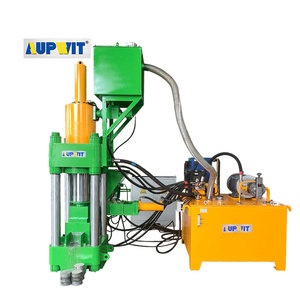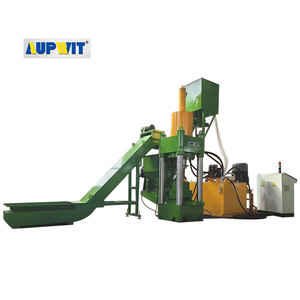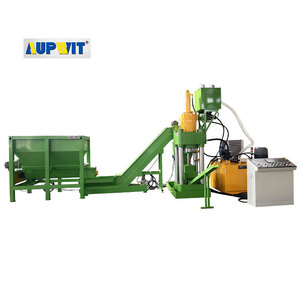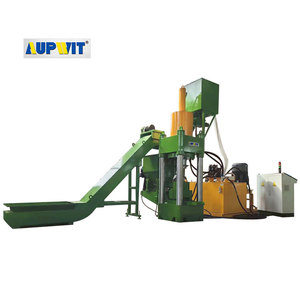
All categories
Featured selections
Trade Assurance
Buyer Central
Help Center
Get the app
Become a supplier

(1323 products available)


















A vertical briquetting machine produces compacted wood, biomass, or metal waste briquettes. It does this by subjecting the waste material to high pressure. There are different types of vertical briquette machines based on design features and functionalities.
In addition to the above types, there are custom vertical briquetting machines. The manufacturer will adapt the machine according to distinct business needs. Large companies may want machines with bigger capacities or built-in shredders and separators. Customization can also include adding different control systems to briquette different materials.
Vertical briquetting machines' specifications vary depending on the machine and manufacturer. The following are key specifications to look at when purchasing this type of briquette maker.
Production capacity
This specification indicates how much briquettes the machine can produce per hour or per day. The statistic is usually derived from factors such as the machine's size, power, and compression rate of the material used. Buyers can find machines with a production capacity of 100-200 kg/hr.
Power
The briquetting machine's power requirements affect operating costs and production capacity. Machines with greater power can efficiently handle large volumes of raw materials. Power is measured in kilowatts (kW) and can range from 5kW to 30kW.
Machine weight and dimensions
Dimension and weight affect installation requirements and production capacity. The weight of the machine can range from 1000 kg to 5000 kg. The dimensions are large and heavy, measuring approximately 2500 mm in length, 1500 mm in width, and 1800 mm in height.
Compression force
The machine applies significant pressure to transform loose materials into compact briquettes. Compression force is measured in tons or Newtons (N). It is available in different tons depending on the material used and the machine model, for instance, 20 tons, 50 tons, or more.
Die and punch
The machine has a die and punch system that forms and compresses the material into briquettes. The die shape and size determine the briquette shape and size. Vertical briquetting machines have replaceable molds that create different briquette sizes and shapes, such as cylindrical or square ones.
Maintenance of vertical briquetting machines enhances durability and keeps the machine performing optimally. Here are some maintenance tips:
Vertical briquetting machines are widely used in multiple industries to recycle various waste products by converting them into compact briquettes. Here are some key vertical briquetting machine application areas.
One of the main uses of vertical briquette machines is to compress metal scraps like aluminum, copper, iron, brass, and magnesium into uniform blocks for easier handling, processing, and recycling. Metal recycling companies use them to reduce the volume of metal chips, turnings, shavings, and other waste products.
A very popular application of vertical briquetting machines is in the wood industry to compact sawdust, wood chips, wood shavings, and other biomass waste products into solid briquettes. These briquettes can be used as a source of fuel, as mulch, or be further processed into charcoal. Other agriculture and forestry industries use them to recycle straw, grass, rice hulls, palm husks, and other biomass materials. The briquettes are also easier to store, transport, and sell.
Vertical briquetting machines are also used to recycle other industrial and manufacturing waste products such as plastic chips, bottles, blocks, and PE/PP/PET materials, packing steel wire, paper, cotton yarn, and other textile rags, sponges, rubber, and leather products. The briquettes can be sold to dedicated recycling companies or sent to an in-house facility for further processing.
Municipal solid waste management authorities also use vertical briquetting machines to compress paper, cardboard, and other reject materials into bales or briquettes to reduce waste sent to landfills. They are also used to recycle food waste, organic waste, and farm waste by compacting it into briquettes that can be used as fertilizer or biogas. By recycling these materials, vertical briquetting machines help reduce the amount of waste sent to landfills and promote sustainable waste management practices.
Business buyers are advised to consider the following factors before investing in vertical briquetting machines.
Assess the production capacity
The first step in choosing a vertical briquetting machine is to evaluate market demand. Consider the amount of raw materials and the desired output. Different machines offer distinct production rates, which directly affect the amount of fuel or final product that the buyer can sell.
Check the material compatibility
Materials differ significantly, each with its unique properties and requirements. To maximize efficiency and effectiveness, business buyers must ensure that the vertical briquette machine they choose is compatible with the particular material they plan to use.
Consider machine automation
When selecting a vertical briquetting machine, consider the level of automation required. Automated machines offer a more efficient production process with less manual intervention, while semi-automatic or manual options may be more cost-effective but require additional labor.
Evaluate machine dimensions
Before purchasing a vertical briquetting machine, buyers must consider the available space in their production facility. The dimensions of the machine will impact the layout and workflow of the entire facility.
Choose machine energy efficiency
Energy expenses can be a considerable operating cost when using a vertical briquette machine. Selecting an energy-efficient machine will help minimize energy consumption and reduce expenses, ultimately lowering production costs.
Q1: Is a vertical briquetting machine profitable?
A1: Yes, investing in a vertical briquetting machine creates a profitable enterprise. The residual raw materials that most industries discard have an outstanding possible return on investment when processed with a briquetting machine.
Q2: What kind of maintenance needs to be done on a vertical briquetting machine?
A2: Regular inspections should be carried out to check for any sign of wear or damage. All parts should be lubricated as per manufacturer's instructions, while filters and cooling systems need to be kept clean. The hydraulic system must be checked for leaks periodically along with electrical components and wiring connections, which should be inspected on a routine basis to avoid any risk of failure. In addition to this, the machine's all fasteners should also be tightened periodically. More importantly, a briquetting machine operator manual will provide specific details about the maintenance schedule of parts, so it is always advisable to refer to it.
Q3: Can a vertical briquetting machine be used for wet material?
A3: No, a vertical briquetting machine is not suitable for wet or damp material. It is essential to dry the material before compacting it with a briquetting press, as this will enhance the quality of the briquettes and reduce wear on moving parts of the machine.
Q4: Does a vertical briquetting machine require employees to operate it?
A4: No. An operator will not be necessary for vertical briquetting machines, which are automatic. However, he may have to feed the raw material into the machine continuously and remove the finished product from it, thus ensuring a constant flow of input material in the machine.
Q5: What is the difference between vertical and horizontal briquetting machines?
A5: In vertical briquette machines, the material is pressed in an upward direction, while in horizontal machines, it is pushed sideways. Vertical machines use less floor space than horizontal ones and are generally more affordable. On the other hand, horizontal briquetting machines are more extensive, suitable for processing large amounts of raw material and producing higher-capacity briquettes.